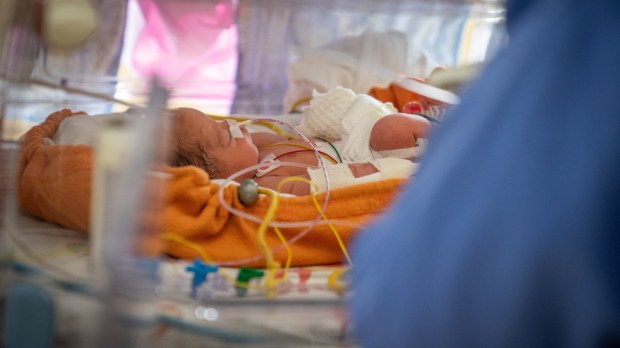When it comes to the medical profession’s response to emergencies during pregnancy, intent is an important consideration.
“The intent of an abortion is to kill the baby, but the intent of a medically indicated separation is to separate the mother and the baby, to save both lives if possible, but if not possible, to save at least one life,” said Dr. Ingrid Skop, senior fellow and director of medical affairs at the pro-life Charlotte Lozier Institute.
Dr. Skop spoke with Aleteia following a US Department of Health & Human Services statement July 11 that said that healthcare providers must offer abortion services if the life of a mother is at risk and that procedures conducted under such circumstances would be protected under federal law regardless of various state bans.
In the statement, HHS cited a 1986 law known as EMTALA – the Emergency Medical Treatment and Active Labor Act – which requires anyone coming to a hospital emergency department to be stabilized and treated, regardless of his insurance status or ability to pay.
Skop doesn’t feel that the statement reflected new policy, for the most part, but a Biden Administration effort to convince people that it’s trying to do something in response to the Supreme Court’s June 24 decision to strike down Roe v. Wade.
“It’s been the situation for years – as long as I can remember – that, of course, if a woman presented to an emergency room with a life-threatening – or any sort of – situation, you’re required, per EMTALA, to stabilize and treat her,” Skop said. “If a woman came in and, because of an emergency, needed to be separated from her baby, every obstetrician will perform that intervention. We always have and always will.”
That’s not necessarily an abortion, however.
What threats exist
One of the most common conditions in which an expectant mother requires medical attention is an ectopic pregnancy, where a fetus is implanted outside the uterus, usually in one of the fallopian tubes. The condition can be treated in a number of different ways, including laparoscopic surgery and medication – methotrexate.
“There is no technology that can put [an ectopic unborn child] back into the uterus, so it is probably going to miscarry, because it does not have a good implantation that can nourish it,” Skop explained. “But as it grows it can stretch the fallopian tube and cause it to rupture, and this can lead to life-threatening bleeding, and a very common cause of maternal mortality is a ruptured ectopic pregnancy.”
Skop said that even in states that have now banned or severely restricted abotion, ectopic pregnancies are covered under the life-threatening exemption. Treatment of it is not an abortion, she said. “Even Planned Parenthood on its website acknowledged that treating an ectopic pregnancy is not the same as performing an abortion,” she said. “There is no question that doctors can continue to treat ectopic pregnancies the same way they always have.”
Other conditions that can arise during pregnancy that require medical intervention include preeclampsia, a potentially dangerous complication characterized by high blood pressure, and rupture of the amniotic membrane very early in pregnancy, before the fetus can survive outside the womb.
“Sometimes this is associated with active labor, but at other times labor is absent, and the clinician is confronted with the difficult decision of how to manage the patient,” Skop wrote in a Charlotte Lozier Institute fact sheet. “The prognosis for the fetus is very poor. The risk of stillbirth is 36%, and about 46% of liveborn babies will die within the first month. Labor often ensues before the baby has reached the gestational age in which he can survive, and even if he reaches the point of viability, the lack of amniotic fluid may cause the lungs to fail to mature, leaving him unable to breathe when delivered.”
“Pre-eclampsia and ectopic pregnancy can be treated clinically and ethically because appropriate treatment does not require killing the unborn child to save the mother,” said John F. Brehany, Executive Vice President and Director of Institutional Relations at the National Catholic Bioethics Center.
Clarifying the law
Clearly, expectant mothers and their physicians can face difficult, heartbreaking situations, but Skop said that only about one out of 10 obstetricians are willing to perform elective abortions.
“If a woman wants to carry her baby, no doctor ever has said ‘You need an abortion.’ What they say is ‘We’re going to follow you very closely and carefully and try to get you through the pregnancy.’ The whole point of maternal-fetal medicine is high risk pregnancy, high risk moms, high risk babies, how do we get them safely to birth. In our country, which has such an amazing medical system, to say to a woman ‘Sorry, we can’t do anything for you. You need to abort’ is giving up. We can care for these women, even if they’re very high risk.”
Nevertheless, since the Supreme Court’s Dobbs v. Jackson decision and subsequent state-level enactment of more restrictions on abortion, many media reports have been quoting physicians about how reluctant they are to perform certain medical interventions in case of pregnancy-related emergencies because they fear prosecution under the new state bans. This, the articles say, is leading to a dangerous landscape for pregnant women.
But Skop believes that the legal vagueness can be cleared up for doctors in a number of ways. State medical societies, with the help of legal counsel, can provide recommendations for their members about what is and what is not included in the law. Hospital committees can help doctors know what the laws say. A special hospital board can be established and prepared to convene at a moment’s notice if there’s a situation where a doctor is not sure what can be done, legally.
“Now that we have this new world where the states are going to be legislating abortion, there should be a very clear process, starting at the level of the state boards, going down to state and local medical associations, going down to individual hospital quality committees, to provide guidance,” Skop said. “I’ve practiced in a Baptist system for 25 years, and of course we don’t do elective abortions. But in these rare situations that I’ve mentioned – a woman is 18 weeks, there’s ruptured membranes, she’s clearly not infected yet, what should we do – we already have systems in place where three doctors, a chaplain, perhaps legal counsel will collaborate and discuss what in this particular situation should be done, and then they’ll make a recommendation on the hospital chart, and it gets done.”
Skop also believes that state governments can clarify laws further. “We have a regulatory state for every other law that’s not clear, right? Congress passes unclear laws all the time, and some bureaucracy at some level will put into place more specifics,” she said. “If it’s really unclear or if it doesn’t offer an exception for life or if there’s something about it that the people of that state say ‘We don’t want this; it’s not right,’ we can always revise our laws.”
Abusing the “health” exception?
In the meantime, Skop fears that the Biden Administration will go beyond EMTALA’s focus on life-threatening conditions and require abortion in less serious cases as well.
“If they persist in saying EMTALA covers not just life-threatening conditions but covers health, I think that’s where they’re going to try to put pressure on physicians to perform abortions that are not clearly indicated,” she said.
Marie Hilliard, Ethics Committee co-chairwoman of the Catholic Medical Association, shares Skop’s concern. Hilliard said recently that the July 11 statement from HHS defines the phrase “emergency medical condition” as “a condition manifesting itself by acute symptoms of sufficient severity (including severe pain) such that the absence of immediate medical attention could reasonably be expected to result in placing the individual’s health [or the health of an unborn child] in serious jeopardy, serious impairment to bodily functions, or serious dysfunction of bodily organs.”
While EMTALA defines the term “health,” the July 11 HHS statement does not. Hilliard points out that in Doe v. Bolton, the 1973 companion decision to Roe v. Wade, opened the door to all abortions, medically necessary or not, based on how the physician and mother defined “health.”
“It became a subjective standard,” Hilliard said in a statement, “which, if applied in this case, would force the Catholic hospital to allow all abortions on demand.”


